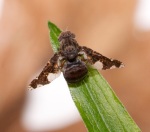
Have you ever wondered what’s inside those hard balls on goldenrod stems?
When I was young, my father had cut them open with his jackknife and used the grubs inside for ice-fishing. And I knew, early on, that they were called galls. But it didn’t dawn on me to wonder what the grubs might turn into or what they were doing there in the first place…until now.
Over the last few years, I began to take an interest in plant galls and have done some research and reading on the subject. The silvery cone galls that form on willows might be my favorites, but the goldenrod galls certainly remain the most conspicuous and most frequently encountered. It seems nearly every stand of Canada goldenrod (Solidago canadensis) one walks through has a few galls, burgeoning among the stems.
These galls are caused by the goldenrod gall fly (Eurosta solidaginis), a well known member of the family Tephritidae, the fruit flies. In fact, so well known are these flies, that a description of their lifecycle is included in my copy of Plant Galls by Margaret Redfern, a British book (part of the Collins New Naturalist series). The female gall fly injects an egg into the developing buds of the goldenrod, using her pointy posterior. The egg hatches and the larva burrows further into the plant and secretes chemicals that cause the plant to grow abnormally around it. The larva feeds on this extra growth throughout the summer, then overwinters safe inside the gall (safe except for the wise chickadees which know how to extract them). At some point, late winter or early spring, the larva pupates and the adult flies emerge soon after, about the time the goldenrod begins to grow late spring. The gall flies mate, after an elaborate courtship dance, and the cycle starts over.
Over the winter, whenever I had the chance, I filled my pockets with intact galls, galls that hadn’t been opened by birds. They’ve been sitting in a heap on my desk for months. This morning, going about some other business in my office, I noticed an odd fly sitting atop one of the vials on the desk. When it moved and betrayed the fact that it was alive, I captured it and placed it in the refrigerator. While it was chilling, I pulled up a small goldenrod plant from the front garden and placed it in container on the table and readied the camera.
This fly, a male, was not a strong flier, even before it was cooled. If it concentrated and focused its energy it could fly about eight inches. The males, according to the literature, walk up and down the goldenrod host, locate a choice spot, lay down some pheromones, and await the arrival of a female. The female gall flies, Redfern reports, use their wings for more than a showy display and have the ability to fly a mile or more in search of suitable host plants.
With more galls sitting on my desk like jack-in-the-boxes ready to spring open at any moment, I’m keeping my fingers crossed for a female gall fly, and doubly crossed (if that’s possible) for one of the wasps that parasitize these flies.




